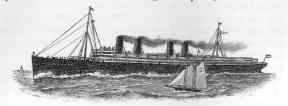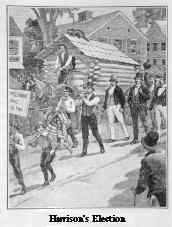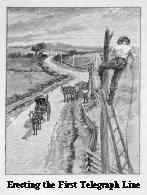Resource Center OLLibrary
|
244 |
|
[1841- |
In time both "clippers" and steamers helped to greatly increase
immigration to our shores. The multitudes who came to America by
these vessel; made the West grow "by leaps and bounds."

A TWENTIETH-CENTURY OCEAN STEAMER
To-day a single one of these huge steamships, some of which
exceed 50,000 tons burden, often brings more than 2000
immigrants.
281. Summary. This period began with a
disastrous panic in trade by which great numbers were ruined; it
was followed by the establishment by the government of the
independent treasury system; then came the vastly increased
emigration from Europe to the United States, the establishment of
lines of European steamships on the Atlantic, and the building of
American "clipper ships." Meanwhile the great Mormon movement to
Utah began.
282. Harrison and Tyler's Administrations
(Ninth and Tenth Presidents, One Term, 1841-1845); how Harrison
was elected; his Death. General Harrison,1 "the
hero of Tippecanoe" (§ 225), was elected President amidst the
wildest excitement. Ever since the election of Jefferson (1800),
or for forty years, the Democrats
1 William Henry
Harrison was born in Virginia in 1773. His father, Benjamin
Harrison, was one of the signers of the Declaration of
Independence. From 1801 to 1813 Harrison was governor of what was
then the territory of Indiana. In 181 1 he defeated the Indians in
a great battle at Tippecanoe, Indiana (§ 225). During the War
of 1812 he was appointed a major general in the regular army.
Later, he returned to his farm at North Bend, on the Ohio, near
Cincinnati. In 1840 he was elected President (John Tyler, a
Democrat of Virginia, Vice President) by the Whig party, by an
immense majority over Van Buren, the Democratic
candidate.
|
1841-] |
|
245 |
|
had carried the day; now their opponents, the
Whigs,1 were victors. Harrison was then living
on his farm, in a clearing on the banks of the Ohio. |
|
246 |
|
[1842- |
and he and the Whig Congress were soon engaged in a series of
hopeless political quarrels.
283. The Dorr Rebellion; the
Webster-Ashburton Treaty; the Anti-Renters. In Rhode Island
the right to vote was confined to persons holding real estate, and
to their eldest sons. Newport, where there were many landholders,
had six representatives in the state legislature, while
Providence, with a population nearly three times as great, had
only four. The party in favor of reform finally framed a new
constitution, and elected (1842) Thomas W. Dorr for governor. The
opposite or state government party, headed by Governor King,
denied Dorr's right to hold office. Both sides took up arms, but
no blood was shed and nobody was hurt. Dorr was arrested and
thrown into prison, but was released a few years later, and lived
to see his party successful in the reform they had attempted.
The same year (184 2) Daniel Webster,
representing the United States, and Lord Ashburton, representing
Great Britain, settled the question of the boundary between Maine
and Canada, by an agreement known as the Webster-Ashburton Treaty.
The dispute in regard to the true line between the two countries
had been very bitter, and the friendly settlement of the
controversy was of the greatest advantage to both England and
America. Furthermore, this treaty fixed our northern boundary
between the Lake of the Woods (Minnesota) and the Rocky Mountains
at the 49th parallel. (Map, p. 358.)
At the same time Mr. Webster declared that in
future England must understand that our flag would protect
American vessels against Great Britain's so-called "right of
search" (§§ 226, 233).
In New York the tenants of the Van Rensselaer
family, on the Hudson (§ 61), refused to pay rent for their
farms, on the ground that the Revolution had swept away the old
Dutch methods of letting land. It became necessary to call out a
military force to protect the sheriff in his attempts to collect
the rents; finally a political party was formed (1843), favoring
the anti-renters, as they were called, and a change was made
(1846) in the state constitution for their benefit.
|
1844-] |
|
247 |
284. The Electric Telegraph, 1844; Dr.
Morton's Discovery. Two years later, 1844, travelers from
Baltimore to Washington saw a force of men engaged in putting up
several lines of copper wire on a row of lofty poles extending
between the two cities. It was the first telegraph line erected in
the United States, or in the world. After four years of weary
waiting, Professor Morse,1 the inventor of the
telegraph, had at length got a grant of $30,000 from Congress for
the purpose of proving that a message could be sent by electricity
a distance of forty miles!
On the morning of May 24, 1844, Professor Morse
took his seat at the telegraph instrument placed in the Supreme
Court Room in the Capitol. Many of the chief officers of the
government were present. The professor pressed the key of the
instrument with his finger. In an instant the waiting operator at
Baltimore received the message, and it was sent back to the
Capitol. Here it is:
• -- -- • • • • • -- -- • • • • • -- -- • • • • -- -- • -- -- -- -- • •
W h a t h a t h G o d• -- -- • -- • -- -- -- • • -- -- -- • • • • • --2
w r o u g h t
In a minute of time these words had traversed a circuit of
eighty miles. When they were read in the Court Room a thrill of
awe ran through those who reverently listened; it seemed as though
the finger of God, not man, had written the message.
Professor Morse's success was complete. He
predicted that some day lines of telegraph would not only stretch
in all directions over the land, but would be laid at the bottom
of the sea between Europe and America. The telegraph accomplished
all that he prophesied and more, for in time it not only crossed
the Atlantic (1866) (§ 367), but the Pacific as well (1902)
(§ 428).
We shall see (§ 373) that more than thirty
years later (1876) the telegraph was supplanted, in a measure, by
the telephone.
1 Samuel F. B. Morse
was born in Charlestown, Massachusetts, 1791; died in New York,
1872. He became an artist, and, in 1830, Professor of the
Literature of the Arts of Design in the University of the City of
New York. He conceived the idea of the electric telegraph in 1832.
Later, his associate, Mr. Alfred Vail of New Jersey, rendered very
important services in perfecting the work. See Century Magazine,
April, 1888.
2 The characters over the printed
letters represent the letters of the telegraphic alphabet, The
words are quoted from the Bible; Numbers xxiii. 23.
NOTE:
Morse code above has been corrected. "d, r, & o" - as printed
in book are not currently correct. We don't know if code has
changed over time or if this was typo in 1920.
|
248 |
|
[1845 |
|
Meanwhile (1871), at a celebration
held in New York in honor of Professor Morse, the
original instrument invented by him was exhibited,
connected, at that moment, by wire, with every one of the
ten thousand instruments |
|
1845] |
|
249 |
285. Our Third Step in National Expansion,
the Annexation of Texas. The great political question of the
times was the admission of Texas. Many years before this period
Stephen F. Austin, General Sam Houston, and other Americans had
settled in that country, -- then a part of Mexico, -- and had
finally, by force of arms, made it an independent republic. The
republic of Texas now asked to be annexed to the United States.
(Map, p. 332.)
A powerful party at the South was anxious to
obtain it for the purpose of making a number of new slave states
out of it, and thus maintaining their influence in
Congress.1 The Anti-Slavery party at the North strongly
opposed the annexation;2 but Congress, after much
debate, decided to make it. It was our third step in expansion
(§§ 215, 238). Thus (March 1, 1845) we obtained a
territory so vast that, as Daniel Webster said, a bird could not
fly over it in a week, -- a territory large enough to make nearly
five countries the size of England, or more than that number of
states, each larger than New York. Texas, however, was not
admitted to the Union until after the next President came into
office (§ 287) (December 29, 1845).
286. Summary. The principal events of the
Harrison and Tyler administrations were: (1) the death of the
President; followed (2) by the Webster-Ashburton Treaty; (3) the
Dorr Rebellion; (4) the opening of the first line of electric
telegraph in the United States or the world; (5) the use of ether
in surgery; and (6) the annexation of Texas.
country: (1) Blanchard's Eccentric Lathe for
turning gunstocks and other irregular forms; (2) McCormick's
Reaper and Mower and Hussey's Reaper and Mower; (3) Colt's
Revolver; (4) Ericsson's Screw Propeller; (5) Goodyear's Hard
Rubber goods; (6) Hoe's Steam Printing Press; (7) Howe's Sewing
Machine. The following inventions came from abroad: (1) Knitting
Machines; (2) Planing Machines (greatly improved in 1828 by
Woodworth); (3) Friction Matches, 1836 (gas had been introduced in
1822); (4) the Steam Fire Engine, 1841, but not brought into
practical use until much later; (5) the Daguerreotype and
Photograph, 1843; (6) the Diving Dress, 1843. On earlier American
inventions, see §§ 205, 220, 252.
1 By the Missouri
Compromise (§ 243) slavery could not be extended west of the
Mississippi, outside of Missouri, north of 36o 30' (the
southern boundary of Missouri). Unless, therefore, the South got
more territory annexed southwest of the Mississippi, the North
would soon have the chief power in Congress.
2 James Russell Lowell's fine poem,
"The Present Crisis," expresses the feeling of the Anti-Slavery
party at this time.
 He
was popularly known as "the Log-Cabin candidate." The
farmers of the West gathered to his support with a will.
They had monster outdoor meetings, and processions miles
long, in which a log cabin on wheels was always a
conspicuous object, with its live coon fastened on the
roof, and its barrel of hard cider standing handy by the
open door. The enthusiasm increased more and more as
election day drew near. The rousing song of Tippecanoe
and Tyler too stirred the blood of all true Whigs, and
with shouts of exultation they sent the occupant of the
Ohio log cabin to reside in the White House at
Washington.
He
was popularly known as "the Log-Cabin candidate." The
farmers of the West gathered to his support with a will.
They had monster outdoor meetings, and processions miles
long, in which a log cabin on wheels was always a
conspicuous object, with its live coon fastened on the
roof, and its barrel of hard cider standing handy by the
open door. The enthusiasm increased more and more as
election day drew near. The rousing song of Tippecanoe
and Tyler too stirred the blood of all true Whigs, and
with shouts of exultation they sent the occupant of the
Ohio log cabin to reside in the White House at
Washington. then
in use in this country. At a signal, a message from the
inventor was sent vibrating throughout the United States,
and was simultaneously read in every city and in most
towns of the republic, from New York to New Orleans, from
New Orleans to San Francisco.
then
in use in this country. At a signal, a message from the
inventor was sent vibrating throughout the United States,
and was simultaneously read in every city and in most
towns of the republic, from New York to New Orleans, from
New Orleans to San Francisco.


